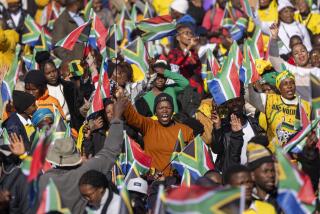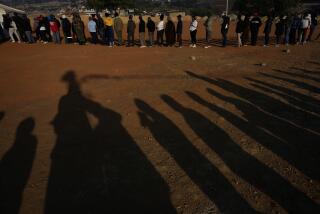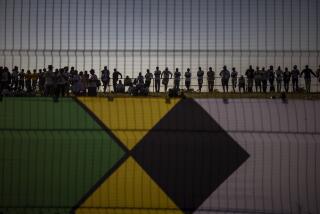South Africa : Is Now the Time? : Sanctions against the troubled country have been lifted, although disturbing problems remain. But after five years there, a Times foreign correspondent found rich scenery and facinating culture to recommend it
JOHANNESBURG, South Africa â Many South Africans like to offer a simple explanation for the split personality of their country. They say that God first created the most stunningly beautiful place on Earth--then, to hide the heavenly favoritism, mortal enemies were chosen to inhabit it.
For some years now, that has pretty well summed up the dilemma for world travelers considering a trip here. Although one of the worldâs most magnificent places, with grand natural beauty, abundant wildlife, perfect weather and a modern infrastructure, South Africa has been better known for racial oppression, civil unrest and, recently, senseless violence.
This nation manages to repel visitors even as it lures them.
Now, as South Africa inches toward multiracial democracy, and as political barriers to travel here fall away, more would-be tourists are asking: Is it time to come to South Africa? And is it safe?
As The Timesâ foreign correspondent in Johannesburg for more than five years, I traveled across South Africa for business and on vacation with my wife and two young children. And I have seen two very different sides of this country.
Like most journalists here, I occasionally have been angrily questioned by heavily armed young vigilantes in black townships. Iâve been at rallies where right-wing extremists packing side arms and huge rifles delivered fiery anti-American, anti-Semitic and anti-black speeches.
But the reality of South Africa is that most likely few, if any, tourists will come face to face with the political violence. Instead, most foreign visitors are cocooned in that other South Africa: the land of beaches, game parks, flowers, forests, deserts and mountains. And many visitors also discover, to their surprise, that this is a nation of very hospitable black and white people with a rich, though undeniably troubled, history.
Should you visit? Thatâs a question I cannot answer.
But I have found South Africa a haunting, fascinating country. The social and political transformation, by itself, is a remarkable sight. And it doesnât surprise me that so many people here, though deeply worried about their future, choose to stay. This territory, part of which the late South African author Alan Paton once described as âbeautiful beyond any singing of it,â exerts a powerful hold on its people.
South Africa covers an area three times the size of California. The topography ranges from the arid western landscape of the Kalahari and the vast central Karoo to the tropical forests on the Indian Ocean in the east and the craggy Atlantic Ocean coastline near the Cape of Good Hope. There also are white-sand beaches, game parks teeming with African wildlife, and miles upon miles of treeless prairies and farmland, which people here call the platteland .
For the politically conscious American, the moral barriers to traveling here should have vanished completely last month when Nelson Mandela, the countryâs most important black leader, called on the world to lift its sanctions against South Africa. By doing that, he acknowledged that the march toward racial equality in South Africa was now irreversible.
But, as anyone who follows headlines from South Africa knows, the transition from white-minority apartheid rule to multiracial democracy has not been pretty. Since the white rulers released their authoritarian grip on political activity, a wave of violence has swept the country, fueled by political animosities between black groups, rising unemployment and mysterious bands of radical blacks and whites who oppose the current reforms. The violence is unlikely to diminish significantly before the first democratic elections, scheduled for April 27.
Does the political violence directly affect the average visitor? Probably no more than gang killings affect the average tourist in Los Angeles. Most of the bloodshed in South Africa, with a few exceptions, has occurred in black townships, not in the major urban centers of Johannesburg, Durban or Cape Town, and not in the game parks or tourist hotels.
The common experience of visitors is isolation from the political crises that arrive periodically. The actor John Lithgow, in Johannesburg for a movie shoot last May, compared it to being on a luxury ocean liner, watching the countryâs travails in the newspapers from the comfort of first-class hotels and restaurants in peaceful suburbs.
But that doesnât mean tourists should feel completely secure. As in any major city in the world, from New York to Paris, visitors to South Africaâs urban centers must be careful. The rate of crimes, from pickpockets to armed robberies to car hijackings, is high. A new target for criminals this year has been restaurants; several dinner-time robberies have led restaurateurs in Johannesburg to install locked gates and allow their patrons in one by one.
Crime has driven most tourists from downtown Johannesburg hotels. The northern suburbs offer better, safer choices for an overnight stay. Among the most expensive suburban hotels is the luxury Sandton Sun, which is connected to a large, modern indoor shopping mall. But there are smaller, cheaper alternatives (see Guidebook).
Most visitors begin their journey in Johannesburg, a modern city of 1 million that reminds me of a Midwestern U.S. city. Egoli (âcity of goldâ), as it once was known, sits on a vast, mile-high plateau. Downtown skyscrapers are fed by a large network of freeways, and the suburbs have large, American-style indoor shopping malls.
The vast northern suburbs, once reserved for whites but now being slowly integrated, are home to South Africaâs upper-middle class. Behind the ubiquitous walls and electrified fences are swimming pools, tennis courts and homes often equipped with South Africaâs favorite separate room, the bar.
Johannesburg is not worth much more than a one- or two-night stop. But it is the best place to get a look at South Africaâs most famous black township, Soweto, a sprawling community of 2.5 million a few iles southwest. Like other townships, Soweto is not safe at night and driving there is difficult even in daytime because few streets have signposts. But several reputable travel companies operate interesting four-hour township tours, which depart from the main Johannesburg hotels.
I have accompanied visitors on these tours and found the guides, usually Soweto residents, informative and refreshingly honest about the damage wrought by apartheid. Riding in a small, comfortable van, you get an unparalleled view of the township, from Baragwanath Hospital, the Southern Hemisphereâs largest, to squatter settlements and upper-middle class neighborhoods.
The itinerary usually includes a pass by Mandelaâs old house and the new hilltop mansion Winnie Mandela built for him (from the proceeds of her autobiography) before he emerged from prison. Mrs. Mandela still lives in the mansion, though her estranged husband now lives in Johannesburgâs northern suburbs.
Some visitors may worry that the tours are exploitative. But they are run independently, instead of by the discredited township councilors of the past, and it seems to me that no one should pass up the opportunity to see how 80% of South Africans live. The legacy of apartheid, unfortunately, still makes it easy for visitors to spend weeks here without seeing any of the townships, which were, by no accident, erected just out of sight of the main roads.
South Africaâs black African heritage is clearly evident from the bounty of art and artifacts, from knickknacks to gallery-quality sculpture. And Johannesburg stores offer a sumptuous supply of paintings, carvings, pottery, beadwork, tapestries and baskets, from South Africa and surrounding countries.
Prices are reasonable, thanks to a strong dollar in South Africa. Each Saturday, the parking lot at the Market Theater, near downtown Johannesburg, is turned over to a teeming flea market. Prices of art and jewelry from Zaire, Ethiopia and Malawi are good, and Iâve often found bargains there. But be careful: The quality can be uneven. Unless you know something about African art, Iâd recommend the reliable, though slightly more dear, selection at the boutiques and galleries in major shopping centers such as The Rosebank Mall, the Sandton City Mall and Village Walk. Bargain-hunters also may find African Magic, in the suburb of Yeoville, closer to Johannesburg, a good alternative.
Joâburg, as locals call Johannesburg, is not the night-life capital of South Africa; Cape Town takes those honors. But Johannesburg does have the countryâs best theater at the Market Theater, housed in the old city vegetable market on the western edge of downtown.
All across the Transvaal Province, which includes Johannesburg and Pretoria, you can find scars and monuments reflecting the history of modern, white-controlled South Africa, beginning with the wagon trains of the Afrikaner trekkers to the discovery of gold and, more recently, to the black liberation struggle.
Pretoria, currently the executive seat of government, is a sleepy town just a half-hour drive north of Johannesburg. The Pretoria Zoo is the countryâs best, and just south of town is the Voortrekker Monument, a giant slab erected by the Afrikaners to commemorate their trek 155 years ago from the Cape to escape British colonial rule and their âGod-givenâ victory over the Zulus at the Battle of Blood River.
A 45-minute drive west of Pretoria is the luxury Sun City gambling complex, which rests on semi-arid land in what is now the nominally independent black homeland of Bophuthatswana.
The resort is sort of an African Las Vegas, with hotels that rival the best in the world. But it is family oriented, with a bowling alley, video game rooms, day-care centers, swimming pools, golf courses and boating on the nearby artificial lake.
Sun City expanded last year with the creation of The Lost City and its Palace hotel, a fancier complex with an artificial beach, mechanical waves, water slides and a bridge that shakes periodically with the âeruptionâ of make-believe volcanoes spewing colorful, hypo-allergenic dust.
Sun City and Lost City each also feature championship, Gary Player-designed golf courses. Although Durban Country Club to the south regularly makes Golf Digest magazineâs list of the worldâs best courses, I find the Sun City courses the prettiest and most difficult tests of golf in a country covered with courses. (One of the holes at Lost City has a water hazard with live crocodiles.)
The creators of Sun City and The Lost City are hoping this resort will become a magnet for world travelers. In December, they will host the Miss World beauty pageant for a second year. And the Sun City stage is drawing increasing numbers of American and European entertainers.
But due to the uncertainty of the countryâs democratic transition, the resort still draws a mostly South African clientele. And, while I have found Sun City to be luxurious and entertaining, it doesnât offer more than a nonessential diversion for Americans on their first visit to Africa.
Kruger Park, on the other hand, is required seeing. The countryâs largest game reserve, on the border with Mozambique and a four-hour drive east of Johannesburg, is richly endowed with elephant, lion, buffalo, hippo, cheetah and other wildlife.
The vast park (at about 26,875 square miles, the size of Massachusetts, Vermont and New Hampshire combined) has a good road network, which is its appeal and its failing. Getting around is easy, but driving off the roads, even to get a closer look or a decent photograph, is forbidden. And the bush can sometimes be quite thick, providing many hiding places for wildlife.
But there is a good alternative. Just outside of Kruger, sharing the parkâs wildlife but not its rules, are a few private game reserves that offer safari experiences similar to Kenyaâs. The most luxurious is Mala Mala, where visitors dine on haute cuisine and South African champagne after guided, four-wheel-drive forays into the bush, where seeing wild game up close is a virtual certainty.
Kruger Park is next to Natal Province, which includes Durban, a large, lively and steamy port city on the Indian Ocean. The city itself has some beachfront hotels, but the beaches are small and crowded. I prefer the modest hotels on the quieter, gray-sand beaches that stretch north and south of the city. The warm waters of Natal are favored by South African vacationers, who swim on beaches protected by fairly reliable shark nets.
In the lush Natal interior, among sugar cane fields and low mountains, the provincial capital of Pietermaritzburg is picturesque. Although the city itself is safe, it is surrounded by townships where internecine battles between Zulus over political power have raged for a decade. For the history buff, Natalâs interior also is covered with old battlefields and military graveyards, reminders of Zulu King Shakaâs battles with the British.
The most beautiful region in South Africa by far is the Cape Province. International air carriers, recognizing the importance of this region, have begun adding nonstop flights from European capitals to Cape Town.
Cape Town is the friendliest of South Africaâs cities, and it has long been known as the most racially relaxed place in the country.
The buildings of Parliament, some of which date from the arrival of European settlers here 400 years ago, make a fascinating stop. Tours are offered only by appointment, but theyâre easy to arrange with a phone call to the public relations office of Parliament and well worth the effort.
The new place to see and be seen in Cape Town is The Waterfront, an attractive collection of up-market shops, restaurants and rocking late-night music clubs on the recently refurbished docks. Boat tours are available there, too, and among the itineraries is Robben Island, where black nationalist Mandela was imprisoned for most of his 27 years behind bars.
The Cape Point, at the tip of the Cape of Good Hope, is a 90-minute drive south along a scenic peninsula, offering breathtaking views of the cold, blue waters of the Atlantic. I never tire of standing atop the sheer rock face of the Cape Point, straining to spot ships rounding Africa on their way to India and the Far East.
The Cape coastline, favored by surfers, is dotted with beach communities and uncrowded beaches of pure white sand. We find the water on the western side of the Cape, washed by currents from Antarctica, too cold for swimming. But the water on the eastern side, just a few miles across the peninsula, is always a few degrees warmer. And among the more pleasant beaches there is St. James, where swimmers still change into their âbathing costumesâ in colorful, Victorian-style changing cubicles.
Our favorite pastime in Cape Town is to take afternoon tea at the Mount Nelson Hotel, joining residents and nonresidents on the veranda or in a lovely sitting room filled with antiques.
If the Mount Nelson is full, as it often is, I recommend taking the 10-minute drive over the mountain from Cape Town to the community of Campâs Bay. The Bay Hotel there offers stunning views of the Atlantic--and, in back, of the mountains. Across the road is a wide public beach, and next door is one of my favorite eateries, Blues, a California-style restaurant with ocean views and an open kitchen that produces delicious fresh seafood and pasta.
An hourâs drive east of Cape Town is Stellenbosch, a pretty town of Cape Dutch architecture nestled in the rolling hills of the countryâs vineyards.
Sampling wine in the region is an informal affair, and wine route guides are free at the information center in Stellenbosch. I recommend a day in the winelands, either making the rounds on your own or hiring a van and driver, as many visitors do, with a stop for lunch at one of the vineyardâs first-class restaurants. The most rewarding part of the journey is the small, family run estates, where, often, the owner himself will serve you his latest vintage along with his theories of wine making.
Stretching east from Cape Town is the Garden Route, a scenic 300-mile car journey that passes forests, mountains and seascapes. There are dozens of pretty little communities along the way, each offering its own idyllic window on a South Africa that is only beginning to be discovered.
THE BLUE TRAIN: One womanâs journey from Johannesburg to Cape Town on South Africaâs legendary luxury conveyance. L16
GUIDEBOOK: Into South Africa
Getting there: South African Airways, in conjunction with American Airlines, offers four weekly 14-hour flights (three nonstop) to Johannesburg from New York, one weekly from Miami to Cape Town (13 hours). From Los Angeles, the round-trip, advance-purchase fare is $2,382, connecting through JFK. British Airways, Swissair and KLM also fly from Los Angeles, connecting with flights in Europe.
Where to stay:
In Johannesburg: The Sandton Sun (from U.S. telephones, call 011-27-11- 780-5000, fax 011-27-11-780-5002), attached to the Sandton City shopping mall in the northern suburbs, is ultra-modern and comfortable; double rooms about $220. It is connected by walkway to the Sandton Sun Towers, which opened a few weeks ago (doubles about $245). More reasonably priced alternatives are the Rosebank Hotel (tel. 011- 27-11-788-1820, fax 011-27-11-447-3276; $110 per double room), a short walk from an upscale shopping mall, with smallish, nicely decorated rooms, and the Balalaika Hotel (tel. 011-27-11-884- 1400, fax 011-27-11- 884-1463; doubles $130), modern but not fancy and connected to the new Village Walk shopping center.
In Cape Town: The Mount Nelson Hotel (tel. 800-237-1236 or 011-27-21- 23-1000, fax 011-27-21-24-7472; $245 per double) is one of South Africaâs finest hotels, due to reopen in mid-December after remodeling following a fire. Children welcome, though the clientele is generally older. The Bay (tel. 011-27-21-438-4444, fax 011-27- 21-438-4455; doubles $175) is luxuriously modern, airy and located in the beach community of Campâs Bay, just 10 minutesâ drive from downtown. The Peninsula (tel. 011-27-21-439-8888, fax 011-27-21-439-8886; doubles $210), a condo-hotel in the first suburb down the coast from Cape Town, is perfect for families, with one- and two-bedroom sea-view apartments with kitchens.
In Durban: The Royal Hotel (tel. 011-27-31-304-0331; fax 011-27- 31-304-5055; doubles $105), a short drive from the beaches, is regularly voted the favorite of business travelers in South Africa. The rooms are pretty and the service super-efficient.
At Kruger National Park: Mala Mala Reserve (P.O. Box Mala Mala, 1353; tel. 011-27-1311-65661, fax 011-27-1311- 65686), bordering Kruger, is a top-class safari camp. Doubles: $475 per person, including meals (cheaper rates may be available through tour operators).
On the Garden Route: Le Quartier Francais in Franschhoek (tel. 011-27- 2212-2151, fax 011-27- 2212-3105; about $80 per person with two meals) is a lovely 16-room hotel in the town where French settlers planted grapes.
Where to eat: In Johannesburg, SantâAna (local tel. 884-5008) in Sandton City shopping complex has Northern Italian cuisine with $10-$15 entrees; Moosehead Grill (tel. 880-6551) in Rosebank Mall features American food, from fajitas to jambalaya (entrees $10-$25); Gramadoelas Africana Restaurant (tel. 838- 6729) in Newtown offers South African specialties, from crocodile to kudu (entrees $10-$30), and Linger Longer (tel. 884-0465) in Sandton serves the best seafood (entrees $20-$35).
In Cape Town: Champers (tel. 45-4335) is small and intimate, featuring French cuisine with local seafood (entrees start at $15); Buitenverwachting (tel. 794-3522), on the wine estate of the same name near town, also serves French-style seafood.
For more information: Contact the South African Tourism Board, 9841 Airport Blvd., Suite 1524, Los Angeles 90045; tel. (800) 782-9772 or (310) 641-8444.
More to Read
Sign up for The Wild
Weâll help you find the best places to hike, bike and run, as well as the perfect silent spots for meditation and yoga.
You may occasionally receive promotional content from the Los Angeles Times.







